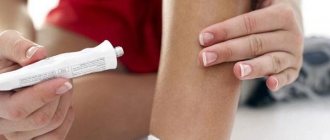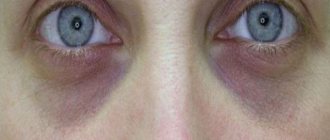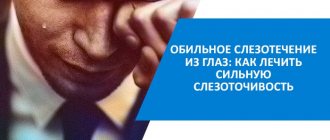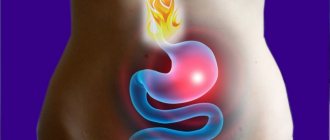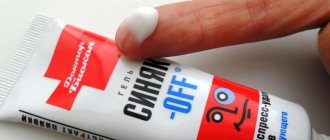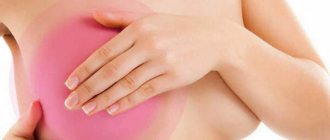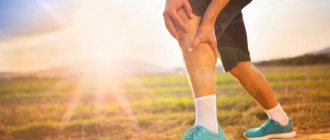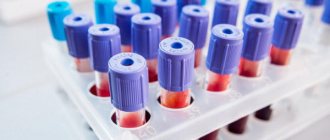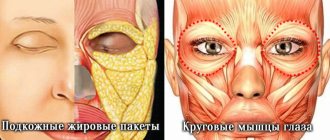Bruise, bruise, hematoma
Bruise
or
bruise
is damage to subcutaneous tissues as a result of a bruise or blow, which is accompanied by internal rupture of capillaries and subsequent effusion of blood into soft subcutaneous tissues.
As a result, a bruise is formed (bruise or in medical terminology - hematoma ).
A fresh bruise has a purplish-purple color due to the hemoglobin contained in the blood . After some time, hemoglobin is destroyed and turns into yellow bilirubin and green biliverdin, the bruise acquires yellow and green shades. After some time, the bloodstream carries the breakdown products of bilirubin, the bruise turns pale, and the skin acquires a normal color.
The size of the hematoma is determined by the amount of blood that has spilled into the soft tissue. The more severe the internal bleeding, the larger the surface of the hematoma and the longer the healing will be.
To resolve a bruise, it is necessary to remove hemoglobin breakdown products from the area where it is located . Blood flow is involved in this, so the rate of healing (resorption) depends on the speed of local blood circulation. Also, due to different rates of blood flow, hematomas in different parts of the body heal differently.
Bruises in the lower part of the body - on the legs, ankles and feet - heal slower than others. And also on all extremities - bruises on the arms and legs take longer to resolve than on the torso. Bruises in the upper body - on the shoulders, chest, neck - heal faster.
A special place among subcutaneous hematomas is occupied by bruises that form after injections. They need to be removed not only as cosmetic defects. At the site of the bruise, a lump forms under the skin. With a long course of treatment, too many lumps form, which make subsequent injections painful. Ointment for bruises after injections allows the formed seals to dissolve.
Therapeutic surgery
In cases of a large hematoma after a bruise on the leg, treatment is carried out using surgical methods. First of all, a puncture is done: the accumulated liquid is removed into a syringe with a special needle. If the joint is damaged, the amount of fluid collected in some cases reaches 60 milliliters.
If the hematoma is accompanied by a fracture of the knee joint, then the surgeon, in addition to removing the blood, performs an operation to apply sutures in the knee area and connect the bone fragments using a metal structure. The patient is placed in a plaster cast, fixing the joint in a given position.
Treatment of injuries with hemorrhage in soft tissues does not always involve a puncture; sometimes an incision is made, the wound is washed and a suture is applied. A hematoma after a bruise on the leg, complicated by rupture of muscle fibers and tendons, also requires surgery. In such cases, sutures are placed in several places, the ultimate goal of the intervention is to restore the integrity of the joints of the muscles and tendons.
If large vessels are damaged, the surgeon applies ligature sutures; at the end of the operation, the wound is drained to drain the blood and prevent re-stagnation of fluids. During the intervention, the hematoma is removed.
Treatment of a bruise: do ointments help against bruises?
In order to stimulate the process of resorption of the hematoma and quickly get rid of the bruise, it is necessary to speed up the movement of blood. How can you help a bruise heal faster?
- Warm up and massage the injury site (heat dilates blood vessels, and massage stimulates blood circulation). For warming up, compresses, baths, and warming ointments are used. Important: warming procedures can be done no earlier than one day after injury.
- Thin the blood and disperse formed blood clots , as well as prevent the formation of new blood clots in the bruise - with medicinal substances.
The use of ointment for bruises on the body combines the above actions . Thins the blood, dissolves blood clots and accelerates the local movement of blood through the vessels.
Note: an effective ointment for a black eye also helps to quickly get rid of puffy bags under the eyes.
Analogs
Foreign manufacturers of zinc ointment use other auxiliary ingredients: lanolin (“wool wax” obtained by processing sheep’s wool), beeswax, a synthetic analogue of vitamin E, cetyl stearyl alcohol, white petroleum jelly (preferably purified). Therefore, imported drugs are more like creams and are absorbed faster.
It is useful to know the difference between zinc ointment and zinc paste in order to use each product correctly. Zinc paste is often called ointment in everyday life. The drug contains 25 g. zinc oxide and 75 gr. excipients. For 1 part ZnO there are 2 parts medical petroleum jelly and 1 part starch. Paste is a more concentrated product.
Salicylic-zinc ointment contains two active substances - salicylic acid and zinc oxide. The drug has antiseptic, anti-inflammatory and keratolytic properties. The product is used to treat eczema and hyperhidrosis.
Sulfur-zinc ointment is a drug used in the complex treatment of seborrhea and psoriasis. The active substances have antiseptic, local irritant, keratolytic, astringent and exfoliating effects.
Other analogues of zinc ointment are Desitin, Tsindol.
Effect of ointment for bruises
As a rule, ointments for bruises and blows contain venotonics
,
anticoagulants
and
angioprotectors
.
They prevent the formation of new clots and dissolve those blood clots that have already formed at the site of the bruise . The instructions for the ointment for bruises contain the names of the main active ingredients. What is contained in ointments:
- Venotonics (another name is phleboprotectors ) - normalize the condition of the walls of venous vessels . They increase their tone and reduce permeability. As a result, swelling is reduced, local blood flow is accelerated, toxins are eliminated faster, and conditions are created for the treatment of inflammation. Venotonics are widely used for the treatment of various types of venous insufficiency (varicose veins, hemorrhoids, thrombophlebitis). They are also included in good ointments for bruises and bruises. The most popular venotonics are hesperidin, horse chestnut extract, troxerutin, quercetin.
- Angioprotectors – accelerate metabolic processes (absorption of nutritional components and elimination of decay products). And this stimulates the resorption of the hematoma (removing hemoglobin breakdown products from the bruising area). The most well-known angioprotectors are Actovegin, troxerutin, tribenoside, vitamins (ascorbic acid, rutin), which are included in ointments for healing bruises.
- Anticoagulants - inhibit the formation of fibrin and the development of blood clots . As part of ointments for resolving bruises, they improve the condition of the blood. They liquefy it and thereby normalize the local movement of blood flow through small vessels. They also eliminate the adhesion of blood cells to the vascular walls. The most popular anticoagulants are heparin, chimes, and iodine-based drugs.
Note: anticoagulants cannot be used immediately after injury - they will slow down the formation of a blood clot in the wound and increase bleeding. The use of anticoagulants is permitted after 24 hours after injury. They also cannot be used if blood clotting is low.
Angioprotectors and venotonics are widely used in the treatment of hemorrhoids and varicose veins. Therefore, as an emergency ointment for bruises and contusions, you can safely use compositions for the treatment of thrombophlebitis, varicose veins, and hemorrhoids.
The pharmaceutical industry produces several dozen different products for the treatment of bruises and contusions. They accelerate the resorption of the existing hematoma and reduce pain at the site of its appearance. They differ in the effectiveness of treatment, the speed of removing blue spots and relieving inflammation. Which ointment helps with bruises better, more effectively, faster?
Heparin ointment for bruises
Heparin ointment is a treatment for thrombophlebitis of hemorrhoids, which is also used as an ointment for bruising and swelling . Heparin in the ointment prevents blood clotting and stimulates the resorption of formed blood clots.
Among the auxiliary components is benzyl ether
, which increases the absorption of heparin.
And also an anesthetic ( anesthesin
or
benzocaine
) - to reduce pain.
Heparin ointment is prescribed for varicose veins, hemorrhoids, elephantiasis of the legs and superficial mastitis, as well as for edema, subcutaneous hematomas, bruises and sprains. This is one of the most inexpensive ointments for bruises. At a very affordable price, it has low (average) effectiveness . Sometimes the product is used as an ointment for dark circles under the eyes, but there are more effective cosmetic preparations.
Prices for Bepanten drugs
The table below shows the approximate prices for Bepanten products available in online pharmacies.
| Name of the drug | Manufacturer | price, rub. |
| Cream Bepanten 5%, 100 g | Bayer | 810 |
| Cream Bepanten 5%, 30 g | Bayer | 452 |
| Cream Bepanten 5%, 50 g | Bayer | 553 |
| Bepanten ointment 5%, 100 g | Bayer | 732 |
| Bepanten ointment 5%, 30 g | Bayer | 431 |
| Bepanten ointment 5%, 50 g | Bayer | 525 |
| Bepanten plus 5%, 100 g | Bayer | 778 |
| Bepanten plus 5%, 30 g | Bayer | 463 |
| Moisturizing body lotion Bepanten Derma, 200 ml | Bayer | 648 |
| Regenerating cream for feet Bepanten Derma, 100 ml | Bayer | 452 |
| Hand restoring balm Bepanten Derma, 50 ml | Bayer | 423 |
Cream Bepanten
Bepanten ointment
Bepanten plus
Bepanten Derma Prices may vary depending on the type of pharmacy chain and its location.
Gepatrombin G - ointment for bruises with a hormonal component
Hepatrombin G is another drug containing heparin. It is also used as an ointment for bumps and bruises. Unlike Heparin ointment, it is a potent agent that contains a hormonal and sclerosing component .
How does the ointment work on bruises, bruises, and contusions? Heparin in the ointment prevents the formation of blood clots and stimulates tissue regeneration. Prednisolone - provides antiallergic and anti-inflammatory properties.
The presence of a hormone in the composition limits the use of the ointment “in any case”
.
Hepatrombin G is not used to treat minor bruises or minor contusions. It is used for large swelling and severe inflammation.
The composition of the ointment is also popular among professional athletes, whose muscles receive microtrauma every day from extreme physical exertion.
Lauromacrogol in the ointment is a substance with an anesthetic and sclerosing effect. It causes the clumping of capillaries that are cut off from the blood flow due to blockage (formation of a blood clot).
Hepatrombin G is contraindicated for bacterial and fungal skin infections . Considering the hormonal composition of the ointment, it is not recommended to use it frequently and for a long time. Too much Hepatrombin G has the opposite effect - it slows down regeneration and healing.
Note: the use of Gepatrombin as an ointment for swelling under the eyes is fraught with addiction. If the skin around the eyes gets used to prednisolone, then when Gepatrombin is discontinued, the bags under the eyes will be very noticeable.
In what cases is Bepanten used?
This drug is very popular. It is found in almost every home medicine cabinet and is an indispensable assistant for all women in caring for their babies. The cream will quickly save you from any wounds (abrasions, cuts, scratches) and burns. It is also used in cases:
- Cracked nipples in women who are breastfeeding;
- Burns of varying degrees resulting from prolonged exposure to the sun;
- Diaper dermatitis and diaper rash in infants;
- Dehydration and dry skin;
- Dermatitis of various nature;
- Frostbite protection;
- Ulcerative processes;
- Cracks in the anus;
- Chronic skin ailments;
- Cervical erosions, etc.
Bepanten is effective against bedsores, eliminates dry skin after using hormonal ointments, dissolves postoperative sutures, cares for problematic skin, protects from cold in winter, and from the harmful effects of sunlight in summer. It can be used as a daily skin care product for the face and hands.
Troxevasin - ointment for bruises
Troxevasin is a fast-acting ointment for bruises on the face, torso, arms, legs and other parts of the body. Its main substance is called troxerutin
.
It is an angioprotector and venotonic at the same time. Troxevasin is produced in the form of a gel for bruises and a remedy for the treatment of varicose veins. Its action is manifested in veins and capillaries. It increases the density of vascular walls and thereby reduces their permeability, strengthens blood vessels and increases their tone , and also reduces the number of platelets that “stick” to the capillary wall.
Troxevasin is used to treat thrombosis, as a remedy for spider veins and capillary networks on the skin . And also for sprains, bruises and other subcutaneous muscle injuries. It is considered the best ointment for bruises on the face and other parts of the body.
Do not use Troxevasin at the beginning of pregnancy and for peptic ulcers in the acute stage.
Dosage forms
Bepanten is a medicine available in several forms. Dosage forms of the drug:
- Ointment 5%. The color is from white to yellowish, the structure is dense, oily. After application to the skin it forms a film. The ointment has a prolonged action, easily penetrates deep into the dermis and enters the systemic bloodstream.
- Cream 5%. It has a delicate texture and is white in color. It does not penetrate into the deep layers of the skin, and therefore does not enter the general bloodstream. After absorption, the cream well moisturizes and cools injured skin areas.
- Lotion. It is a delicate emulsion with a milky white or slightly yellowish tint. The lotion cools and relieves pain on burned areas of the body.
Another form of medication is also available - Bepanten Plus Spray. In addition to dexpanthenol, the composition includes chlorhexidine, an antiseptic. The use of a spray protects damaged skin from pathogenic microorganisms. Spraying an aerosol is especially convenient for extensive burns, since this method of applying the medicine ensures that a large area of the body is treated at once.
Ointment Rescuer from bruises
Rescuer is an ointment with a regenerating effect. It contains a complex of wound-healing and anti-inflammatory components. Among those that stimulate tissue regeneration is sea buckthorn oil
,
lactic enzymes
.
To treat inflammation - tea tree oil, propolis, turpentine and lavender oil, echinacea extract
.
The complex composition of Rescuer exhibits a strong antibacterial effect and effectively helps treat open wounds. As for the treatment of closed wounds (bruises and bruises of any origin), here the Rescuer is less effective. Its use as an ointment that resolves bruises is insufficient .
Rescuer can be used as an ointment for abrasions and bruises. When there is damage to the outer skin and subcutaneous tissues . In this case, most ointments with antithrombotic effects are contraindicated.
For such injuries, the Rescuer will treat the skin and subcutaneous tissue. Stimulate the regeneration of the outer epidermis and resolve existing bruises. Reduce inflammation, protect against bacterial infection and relieve pain.
Another advantage of the Rescuer is that it can be used as an ointment for bruises and contusions for children of any age . Contains natural ingredients and does not cause side or allergic reactions. Although its effect specifically for resolving bruises is significantly lower than that of Heparin ointment or Troxevasin.
Contraindications for use
Whatever type of ointment it is, it cannot be used to treat abrasions and scratches. Apply the product to the damaged area with caution. Treatment with ointments should be carried out in cases where there are no other injuries besides the bruise. This is especially true in cases where a joint has been injured, or a head or abdominal injury has been sustained.
It is important to remember the side effects of using ointments, which can cause:
- allergic reactions;
- itching;
- burning;
- nausea and gastrointestinal dysfunction.
Drugs classified as non-steroidal anti-inflammatory drugs should not be used:
- for problems with the kidneys and liver;
- pregnant women;
- children under 5 years of age.
Badyaga - ointment for bruises
Badyaga is sold in the form of a powder for dilution and preparation of a paste (ointment) and in the form of a gel. This ointment for bruises on the legs, arms, and torso contains natural ingredients ( silica
- a breed that is composed of the skeletons of freshwater coelenterates of the Badyagov family). The composition of Badyagi is traditionally used to treat joint inflammation, rheumatism, as well as for injuries (bruises, sprains, bruises).
The main effect of Badyagi is to stimulate regeneration, exfoliate old skin and restore new skin cells. Side effect is the expansion of capillary blood flow and improvement of blood circulation, as a result of which bruises, bruises and other infiltrates resolve (vasodilation stimulates the irritating effect of silicon oxide needles). Badyaga also has anti-inflammatory and bactericidal properties.
Badyagi powder can cause microtrauma to the skin (silica needles). This determines the specifics of using the powder - it cannot be rubbed in .
Note: the ability to cause microtrauma was used in the 19th century in cosmetology. Blush was made based on Badyagi, which caused a persistent red color in the area where the cheeks were rubbed with this powder.
Badyaga is not used as an ointment for bruises for children. It is also contraindicated in the following cases:
- in the presence of abrasions on the skin;
- in the area around the eyes - do not apply Badyagu;
- Do not smear inside the nose, on the lips and other mucous membranes.
First aid
The appearance of any type of hematoma is a reason to consult a doctor. During the examination, a traumatologist excludes or confirms a bone fracture, the degree of danger and prescribes treatment in a hospital setting or sends the patient home with treatment recommendations.
First aid is provided immediately after a hematoma appears after a bruise on the leg. Treatment and initial measures consist of creating peace for the patient. The injured limb is placed on an elevation created from improvised means (pillow, cushion, etc.).
Cold is applied to the affected area. This can be an ice pack, a frozen plastic bottle, wrapped in a towel, etc. The cold compress is kept for up to 30 minutes in several doses with a break of one hour. Over the next three days, cold compresses are also indicated.
Ointments based on bee venom for bruises
The effect of bee venom has not been fully studied. We only know that it stimulates the immune system. Moreover, the effect of bee venom is 30 times stronger than that of snake venom.
Bee venom in emergency ointments for bruises has a local anti-inflammatory and absorbable effect. It accelerates blood flow and enhances cellular immunity. Dilates blood vessels and causes a local increase in temperature in the application area.
Bee venom is one of the few natural ingredients with a diverse effect:
- counteract inflammation and infection by pathogens (is an antiseptic);
- warms and accelerates the blood;
- relieves muscle spasm;
- enhances cellular immunity.
The main purpose of ointments based on bee venom is the treatment of chronic joint inflammation with severe pain (arthritis, osteochondrosis, rheumatism). They are also used as an ointment for bruises and hematomas on the face, torso, and limbs . What drugs are produced based on bee venom?
| Apisatron is a multicomponent composition, which contains bee venom, mustard oil, methyl salicylate (salicylic acid ester). The action of the listed components complements and enhances each other. Apisatron is intended for the treatment of muscle and joint pain. Shows anticoagulant and anti-inflammatory effects. Accelerates the resorption of small bruises and large hematomas. Used to treat adults. |
| Virapin is a composition with a minimum amount of auxiliary components. It contains only bee venom and Vaseline. It is positioned as an analgesic and anti-inflammatory agent, an approved ointment for bruises for children from one year old (provided there is no allergy to bee venom). |
Note: 1 g of ointment is equal to the poison content of 1 bee sting.
Interaction
Rare complications of Bepanten use include:
- redness, irritation, itching, tingling, burning;
- contact and allergic dermatitis, eczema;
- cough, shortness of breath;
- pinpoint rashes, the appearance of blisters.
In the overwhelming majority, this is not a reaction to dexpanthenol itself, but to auxiliary components (cetyl, stearyl alcohol, lanolin). It is important during the treatment process not to allow the drug to come into contact with the eyes, and caution is also required when applying Bepanten ointment to the genital area or perineum.
If you use condoms for contraception during use, their strength is reduced due to the effect of white paraffin on the latex.
Thai ointment for bruises
The effect of Thai ointment for bruises on the face and other open parts of the body depends on the components it contains. Pharmacies offer several types of Thai ointments - for massage and relaxation, for joint pain, warming for colds, for insect bites. To treat bruises and sprains, it is recommended to use yellow, orange, red and black Thai ointments. They relieve muscle pain and eliminate inflammation. They also have some resolving effect on hematomas.
Application rules
It is important to know the rules for applying such products.
They differ depending on what type of injury the baby has:
- With sprains. If the baby has suffered a sprain and complains of pain, it is necessary to lubricate the injured limb with ointment and take the child to the emergency room.
- If bruises appear, the first thing to do is apply ice to the affected area. It will relieve the swelling, and then you should apply one of the ointments.
- Sometimes ointment alone is not enough and you need to apply a tight bandage over it.
- Medicines intended for the extremities should not be applied to the face as contact with the mouth or eyes will cause severe reactions.
- In case of bruises, the site of impact is thoroughly washed and covered with a medication that relieves the inflammatory process.
Reviews
Tatyana, 40 years old
I want to buy ointment for bruises. Please advise which one is better?
Marina, 22 years old, Moscow I advise: I applied several ointments at once - heparin, badyaga and troxevasin. Removed a bruise on my face in three days. Since I doubted whether heparin ointment was effective enough for bruises, I immediately used everything that was recommended to me.
Anna, Omsk Heparin - so-so. The bruises, of course, go away, but they will go away even without ointment. The product is weak, but whatever you want, it costs a penny. The two best ointments for bruises are Troxevasin and Lyoton.
How to use for children
Zinc ointment for diaper rash in newborns and infants is used under a diaper. Apply the product before bedtime so that the child does not experience discomfort due to skin irritation.
If diaper rash does not go away within 7 days, contact your pediatrician.
Zinc ointment is used for children with sensitive skin susceptible to diaper dermatitis. Lubricate the skin around the anus and buttocks. A thin layer of the drug creates a barrier against the aggressive effects of feces.
The product is not used on the genitals.
The drug is used to eliminate itching in the anus caused by the activity of tiny parasites. Zinc ointment is used for pinworms in children at night. The child is less bothered by the discomfort associated with the release of parasites from the intestines.
Zinc ointment for chickenpox is needed to reduce itching in the area of the blisters. Apply the drug 1-3 times a day.
